Table of ContentsClose
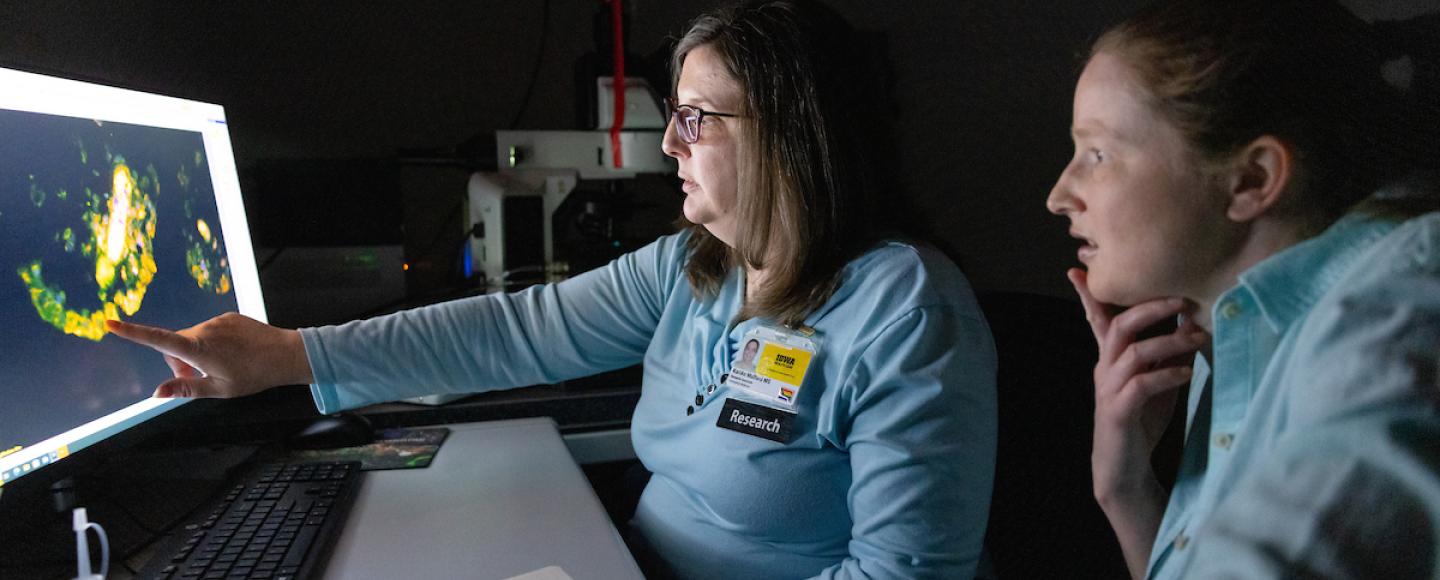
Reimagining emergency medicine
A heightened emphasis on collaborative research is helping reshape emergency care.
While still a relatively new discipline compared to other academic medical specialties, emergency medicine historically has focused on acute clinical care—and clinical education and training—to the near exclusion of research.
“People think about emergency medicine physicians as the resuscitation experts, and we pride ourselves on that,” says Andrew Nugent (96MD), clinical professor and chair of the University of Iowa Carver College of Medicine Department of Emergency Medicine.
But the scope—and impact—of emergency medicine is changing.
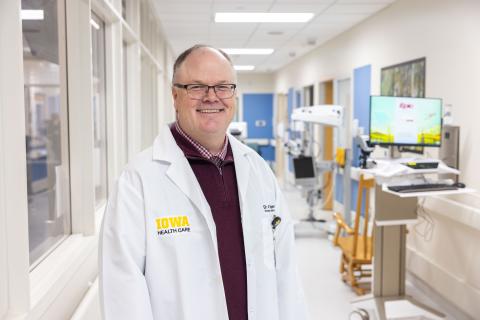
At Iowa, Nugent and his department’s faculty are prioritizing emergency medicine research to drive a deeper understanding of emergency health problems—and how to better address them. The effort is wide-ranging, with UI researchers exploring stroke triage, telemedicine, sepsis, domestic violence, all-terrain vehicle injuries, and more. These efforts are resulting in new applications, research pathways, and clinical trials.
“We now have the people and the ability to do complex clinical studies in the emergency department that would have been impossible 15 years ago,” Nugent says. “Emergency medicine research is growing rapidly, both here and nationally, and we’ll continue to make great strides in the years to come.”
Charting a new course for emergency medicine
For over a decade, the Department of Emergency Medicine has been building a research culture that’s gone into “hyperdrive,” Nugent says, thanks to the leadership of Nicholas M. Mohr (06MD), professor and the department’s vice chair for research.
“We conduct broad-based emergency care research so that we can learn how to better take care of people who have time-sensitive acute emergencies,” Mohr says.
Such sweeping efforts are pulling in researchers and doctors from across UI Health Care’s clinical enterprise and, in some cases, from across the globe.
“My colleagues and I interface with every single specialty that a hospital offers,” says Karen Cyndari, MD, PhD (22R), assistant professor of emergency medicine. “I need to know the ins and outs of the emergencies of every single one of those specialties in order to know how to treat them.”
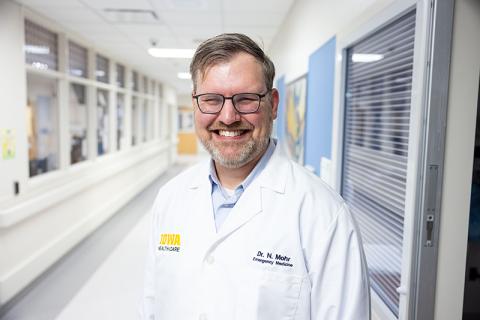
Helping paramedics decide where to take stroke patients
One such initiative at Iowa is helping patients before they ever step foot in a hospital.
When paramedics treat someone who has had a stroke, they have precious little time to answer a fateful question: Where do they take the patient? Should they take the patient to the closest hospital? Or should they drive farther to a health care center that can provide clot-busting drugs, or to a regional care center that can provide surgical treatment?
Taking a stroke patient to the nearest hospital gets that individual treated faster—but it also sometimes means delaying other, potentially more effective treatments. And when treating people who have had a stroke, time is of the essence.
“With other diseases, it’s really clear for paramedics to know where to go. With stroke, different hospitals can provide different treatments,” Mohr says. “The decision of where a patient is treated first can be one of the most consequential decisions in stroke recovery. That decision affects whether a patient qualifies for therapies and how quickly those therapies can be applied.”
The UI’s MAP-STROKE project—launched three years ago by a multidisciplinary team of Mohr, Santiago Ortega-Gutiérrez, MD, a clinical associate professor in the Carver College of Medicine Department of Neurology, and Grant Brown (15PhD), a biostatistician in the UI College of Public Health Department of Biostatistics—aims to make evidence-based destination recommendations to paramedics via a mobile app.
Paramedics enter the patient’s symptoms into the app, which determines how far they are from the closest hospitals and regional stroke centers. The app quickly predicts the patient’s outcome if that individual gets drugs in one site versus surgery in another. Mohr and the rest of the MAP-STROKE team hope to have a prototype of the app within the next two years.
“Our vision is that a personalized, data-driven destination recommendation in an app can be used by paramedics throughout Iowa and the country to improve stroke outcomes,” Mohr says. “One of the things I think is great about the University of Iowa is this collaborative environment. We see it in our research, clinical care, and educational programs.”
Emergency access
As the Department of Emergency Medicine expands its research and clinical education efforts, it’s also expanding access to high-quality care. Emergency department locations include:
- Downtown campus
- University campus
- North Liberty campus (coming soon)
Collaborative infrastructure for antibiotic advances
Anyone who’s ever taken antibiotics is familiar with the routine: Take all the pills you’re given, even if you’re feeling better. The thinking has been that stopping the antibiotics too soon could place an individual at risk for recurrence of illness or even for resistance to the drugs.
But the field of infectious diseases has been turning away from this approach and pushing for shorter antibiotic treatment durations. Now, the understanding is that the longer a person takes antibiotics, the likelier they are to develop resistance to the drugs or experience adverse effects.
This shift in thinking led Brett A. Faine (07PharmD, MS), a UI clinical associate professor in the Department of Emergency Medicine, to explore the viability of a one-size-fits-all approach to antibiotics.
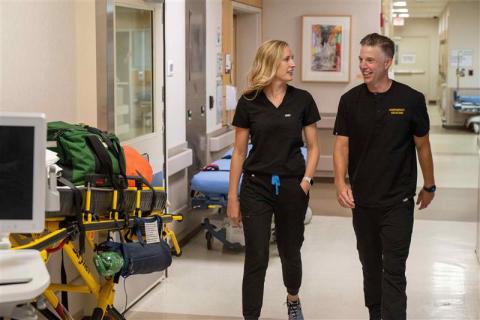
Faine, who also holds a faculty appointment in the UI College of Pharmacy, launched the SAY-STOP trial in mid-2024 in collaboration with Department of Emergency Medicine colleagues Anne Zepeski (16PharmD), and David Talan, MD, co-principal investigator for the SAY-STOP trial. Zepeski, a clinical assistant professor, also has a faculty appointment in the UI College of Pharmacy. Talan, a clinical professor, holds a joint faculty appointment at UCLA.
The SAY-STOP trial is exploring if it’s safe for female patients with pyelonephritis—a severe urinary tract infection—to stop taking their antibiotics once they feel better. For this trial, the researchers use an app to follow the patients’ symptoms daily. When their symptoms resolve, the study participants either continue with the antibiotics or switch to a placebo (without knowing which pill they’re taking). The researchers then follow the participants for 28 days to see if they experience a recurrence of illness or any adverse effects and need more treatment.
“We’re doing long-term follow-up to make sure this is not a short-term fix but a sustained treatment cure,” Faine says. “We hope this represents a paradigm shift in how we think about antibiotic durations—not only for pyelonephritis but for other infectious diseases.”
After gathering data from the pilot study’s 40 participants, the researchers hope to conduct a multicenter clinical study with hundreds of participants.
The SAY-STOP pilot has been enabled by the Department of Emergency Medicine’s extensive research support, Zepeski says. Case in point: Full-time research assistants are available in the hospital 24 hours a day to enroll patients as study participants in emergency care clinical trials—even if they show up seeking care in the UI Health Care medical center’s emergency department at 4 a.m., for example.
“The fact we’re able to enroll patients at all is because of the incredible research infrastructure that’s available,” Zepeski says.
Iowa: a place to grow emergency medicine research
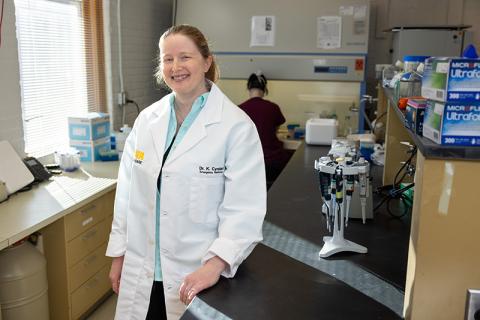
In 2011, when she entered an eight-year MD-PhD program in New York to become a physician-scientist, Cyndari expressed interest in studying emergency medicine.
However, “I was told that was absolutely not possible as a specialty because emergency medicine physicians do not do research,” Cyndari says.
At the time, there was little or limited infrastructure to support research in emergency medicine at many academic medical centers. But Cyndari knew she wanted to both practice and research emergency medicine.
“I love treating everyone and everything,” she says. “I love being useful in any medical situation.”
In 2019, with her MD-PhD in hand, Cyndari discovered she could pursue both passions as a resident physician in the UI Department of Emergency Medicine.
“Not many people were interested in fostering a research pathway for emergency medicine,” Cyndari recalls of her interviews at other residency programs across the country. But when she explained her interest in researching orthopedics and immunology with the Department of Emergency Medicine, “They said, ‘Wow, we’re really excited about that. How can we help?’” Cyndari says.
The department created a Physician-Scientist Training Pathway (PSTP), which provides clinical training and resources for physician-scientists to conduct research. While PSTPs are well established in other medical fields such as pediatrics and psychiatry, they did not exist in emergency medicine. UI Health Care established the PSTP for emergency medicine in 2019, with Cyndari as its first resident.
“It was the first of its kind in the country,” Mohr says. “We want to continue to develop Iowa as a place where physician-scientists and emergency care research can thrive.”
During her residency, Cyndari conducted research on topics such as septic arthritis and inflammatory arthritis. For her, it made perfect sense to study these conditions in the emergency department, which sees a lot of people with joint pain. The goal of her work, Cyndari explains, is to preserve human mobility into older age.
“I think Iowa is ahead of the curve because emergency medicine is rapidly heading in the direction of an emphasis on research,” she says.
One sign of the PSTP’s success? Both Cyndari and the program’s other graduate to date, Melvin Donaldson, MD, PhD (23R), are now faculty members in the Department of Emergency Medicine.
As the field continues to shift from thinking entirely about caring for patients in the moment to also considering how any care could affect them over the long term, the question Cyndari says she and her colleagues ask is clear:
“How can what I do now give patients the best chances for the best outcome for the rest of their life?” she says.
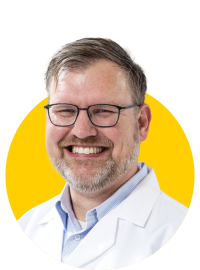
Telehealth's effects on rural populations
Telecommunication has made inroads in many areas of modern life: banking, education, and retail, for example. But telehealth is still an emerging field.
When UI Health Care’s Rural Telehealth Research Center launched around a decade ago, “not many people used telemedicine to receive health care,” says Nicholas M. Mohr (06MD), who directs the center, a collaboration among the University of Iowa, the University of North Carolina-Chapel Hill, and the University of Southern Maine.
But after the COVID-19 pandemic and some policy changes, the use of telehealth saw a “dramatic increase,” according to Mohr.
“Now, most of us have seen what telehealth looks like and what it can be,” he says.
The center, which conducts research that informs public policy, focuses on patients in rural populations to understand how telehealth can be used to help improve health access and outcomes. For example, the center’s researchers have looked at how telehealth can be used to prevent hospitalizations for people with chronic diseases, and how telehealth in rural emergency departments can improve the care and survival of patients with sepsis.
“At the University of Iowa, we’ve been leaders in conducting policy-relevant research related to telehealth,” Mohr says. “It’s really about trying to reimagine what health care ought to look like using virtual tools.”
Photos by Liz Martin and Justin Torner
